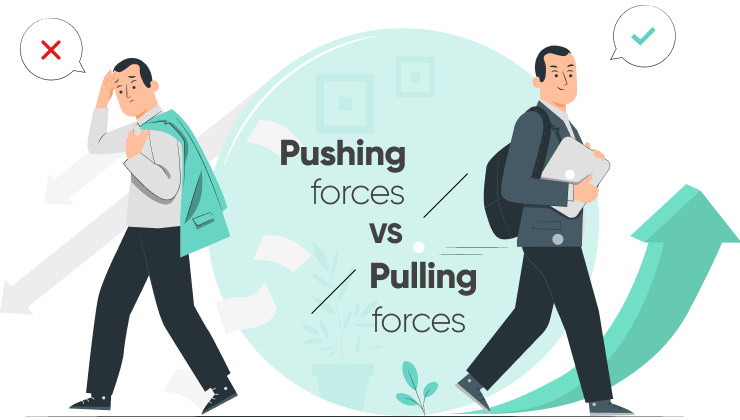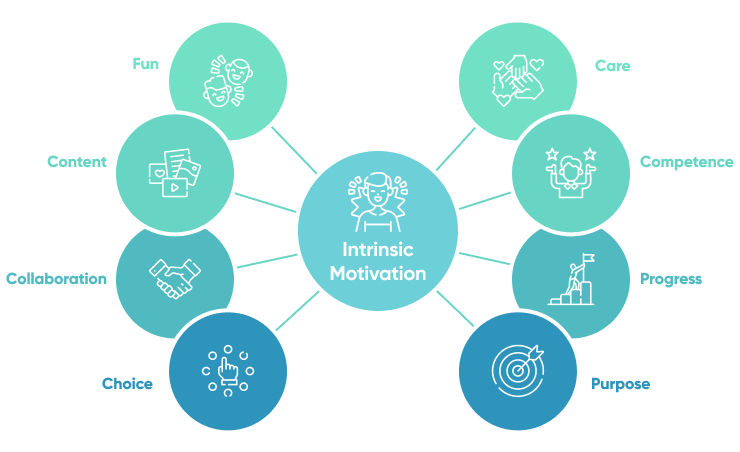At the time of writing this article, there is a battle happening in the IT industry. The battle is not even for the best talent, but for any talent at all.
Most of the parties in this battle are on the offense and defense at the same time. On one hand, companies are luring new candidates with high salaries, promises of exciting projects, gym memberships, and many other perks; on the other hand, the same companies are using these perks to keep their existing employees.
Some of those "lures” are straight-forward and easy to verify quickly after joining a team. Others are more intangible. For instance - what does an "exciting" project actually look like? What does "great company culture" really mean? How can I be sure it is real and not just HR marketing mumbo-jumbo?
Forces and motivators
There are two kinds of forces continuously influencing employees in the workplace.
The first are pushing forces. Pay-check a week late for the fourth time in the row? Literally zero reaction for yet another idea you have presented? A total jerk in the team everybody just seems to tolerate? Things like this contribute to pushing people out of the company and should be avoided at all costs.
Well defined management processes, strong leadership, and solid company culture are very effective tools to prevent these pushing forces from manifesting. All in all, these pushing forces are quite obvious and easily identifiable.
In this article we're going to look at a less obvious set of forces we call pulling forces. These are the things you would miss when leaving the company and also the ones that are a bit harder to identify, build, and nourish. I will refer to them from now on as "motivators.” These motivators can be divided into two groups: extrinsic and intrinsic.

Extrinsic and intrinsic motivators
When you think about what motivates an employee, what initially comes to mind might be a good salary and perks like a gym membership or free lunches. These types of motivators are called extrinsic motivators. They can be easily replicated and become a widely-adopted standard amongst companies. In fact, employees have come to expect a certain amount of perks from tech companies these days.
Therefore extrinsic motivators usually act as "hygienic" factors. When at a reasonable and healthy level, their role is to not bother you. They will, however, rarely motivate you to give your best or feel a deep connection with your team or company. Scaling up these extrinsic motivators usually has marginal positive effects. And, in the worst case, scaling them up can have a negative effect. Imagine an employee who is, by all accounts, unhappy, but is staying in a role because of the money and perks. This is, of course, not an ideal situation for the employee or the business at large.
The truth is, we all need something more... something which resides deep within us.
Managers often ask behavioral scientists: “How do you motivate people?" Douglas McGregor famously said "You don't."
“All we can do is set up certain conditions that will maximize the probability of their developing an interest in what they are doing and remove the conditions that function as constraints.” - Alfie Kohn
This is where intrinsic motivators come in. These intrinsic motivators are not as straight-forward as extrinsic ones. They sit below the surface rather than in plain sight. But, to build a strong, motivated and engaged team, we need these two types of motivators to work in tandem.
Below is my take on 8 factors contributing to the certain conditions which may allow intrinsic motivation to flourish and work its magic. Mondays may become something your team is looking forward to with enthusiasm instead of dread.

Fun
Develop a clear and concise plan for your software development project from the outset. This will help to ensure that everyone involved understands the goals and objectives, and can work towards them more effectively. There is no one-size-fits-all answer to this question, as the best way to develop a clear and concise plan for a startup software company will vary depending on the specific company and its goals. However, some tips on how to develop such a plan include:
Well, this one seems self-explanatory. Who doesn't want to go into a workplace where you can have fun? It doesn't necessarily mean playing a PlayStation for 2 hours straight every day (but it could).
For starters, as a leader you can stimulate the "fun aspect" by at least having some sense of humor. Sometimes a well landed one-liner can discharge a highly volatile situation and even strengthen comradeship in the team. Turning chores into challenges (and making them effectively a fun thing to do) is also a way of bringing more fun into the workplace. Hosting team-building events is another way to contribute to the fun-factor. Just be there with your people, play games and let the bonding happen. Last but not least - some fun just happens organically. Cherish it, help it flourish and by any means! If it does little to no harm to the company and its culture - simply DO NOT MESS WITH IT.
Fun activities can look like slacking to an untrained eye. You need to see well beyond this facade to not turn this "pulling-in" force into a "pushing-out" one.
Content
On many occasions we do not have the luxury of picking the tasks that are the most exciting, the most rewarding, and generally the most attractive for given people. There is a job to be done, goals to be met and tasks that we need to assign to somebody.
Still, the task of allocating people to the work at hand shouldn't be neglected. You should be aware of the strengths, weaknesses, aspirations and the current situation of each of your team members. Do your best to assign them the most appropriate tasks with the information you have about them.
Some of the tasks you assign them may stimulate growth by pushing them outside of their comfort zone. Other tasks may allow them to manifest their competence to the fullest. Others may let them slow the tempo down. Finally, some tasks will not be a good match for a particular (or any) person in your team. That is fine from time to time, but if this is a permanent situation, you should strongly consider acting on it.
Take the time to consider the work required of your team, evaluate the competencies and personal situations of each member of your team, and assign tasks intentionally. The content of the work you assign can have a significant impact on employees' motivation to do the work well.
Collaboration
Even the most challenging situation feels less frightening with someone else by our side. Even the most complex problem can be addressed when there are many pairs of eyes and minds focused on it. Even the most boring task feels a bit better when we can share the effort with somebody else. Collaboration is key to much of the work in our modern society.
Whenever there is a chance and reason for it, pair or group people up and foster collaboration between them. Especially when the task is hard and stressful, the struggle to tackle the challenge can be immensely bonding. This can help build high levels of trust and stimulate learning behind the scenes.
In contrast, being alone with your keyboard for extended periods of time rarely results in anything positive for most people. Therefore make sure you are intentionally designing collaborative experiences for all team members.

Choice
While in some situations a small dose of micromanagement is expected and necessary (even if only for training purposes / proximal-development), most people hate being micromanaged.
Micromanagement can manifest not only when actually working with the person directly but also by the level of detail provided around a given task. When all decisions are always already made for you, all risks pre-analysed, all ideas researched, you end up as a mere executor of the work. This can quickly become boring, growth-stifling and discouraging.
Again, this surely can work in some situations, for some categories of tasks and for some people, but this is a dichotomy you need to keep balancing consciously. As a rule of thumb, whenever possible, leave people some meaningful choice, some room to maneuver - even if they cannot choose what to do, it can be liberating to decide how to do it.
Care
Well structured and executed one-on-one meetings are one of the most powerful factors in indicating that a given company deeply cares about their employees. It shouldn't be a surprise that the meeting itself has little impact. The contents of the meeting, the focus, atmosphere, trust and relationship being built along the way is what truly matters.
Keep in mind that as a person leading such meetings, you should always start from the position of care. Building a level of trust early in a relationship can allow for candid feedback to be taken well on both sides. Genuinely caring about your employees and spending uninterrupted time with them can go a long way. Often employees gain a deep sense of motivation from the personal relationship they have with their team leader or manager. Ensure you use one-on-one meetings to intentionally develop this relationship, while not being oblivious to the consequences of doing them badly.

Competence
There's nothing more satisfying than being able to use your strengths to provide clear and significant value. It can be immensely impactful if you, as a leader, craft conditions for this to happen on a regular basis.
This can be implemented by caring about a person's growth and nurturing that growth over time. As they develop competence in a new area, assign the right workload, so that the acquired competence can be used to the fullest.
This is an area that should be reevaluated often, as people's interests and skills can change rapidly. As a leader, you should be aware of your team's everchanging competence in varying areas and work to intentionally develop it over time.
Progress
Even the most mundane tasks feel a little bit better when we see the end on the horizon. Complex tasks are less overwhelming when broken down into easily achievable steps.
Help your people see the progress by providing a means for them to see their work in context of the bigger picture. Facilitate progress tracking by using project management tools, communicate progress openly, and celebrate it on a regular basis.
This can be achieved on a small or large scale. Seeing how small tasks fit into a project's progress can be helpful and motivating, but it can also be helpful to see how individual work fits into the company's longer-term progress toward its revenue, product, or other goals.

Purpose
Having a clear purpose is important at all levels of an organization. The individual level is no exception. As leaders we should ensure that all of our decisions, actions and goals are rooted in a clear "why?", and that this reasoning is effectively communicated to each member of our team. Everyone should understand how their work fulfills their individual purpose as well as the purpose of the project, team, or company at large.
For this to happen, we should also relentlessly strive for clarifying purpose whenever we interact with our peers, customers and other people in the organizational hierarchy. Knowing "why?" is sometimes the key aspect that sparks enthusiasm in executing an otherwise dull job. Lack of purpose, on the other hand, can render even an interesting assignment a chore.
Take the time to clarify for each team member how their work fits into the team, organization, and company's purpose. Formalize it. Overcommunicate it. Then, this should be revisited as often as projects and focus areas change to ensure everyone can see their value and true purpose.
Conclusions
So what does all of this mean to you as a leader?
First of all, it is highly unlikely you will ever manage to nourish the full set of intrinsic motivators at the same time for all team members. On most occasions you need to give one or a few factors up to focus on others. But, you should never lose the overall perspective as conditions and contexts may change that suddenly allow you to boost one or more of the intrinsic motivation factors to a new level with little effort.
So how do you maintain this oversight?
To me, the best known tool is the regular one-on-one sessions with your staff. Asking questions with genuine interest such as "How's your week going?” or “What's been on your mind this week?" can be a great starting point for building trust, relationship and yes - care.
This is only the start of viewing your team with a lens of intrinsic motivators. Challenge yourself to dig deeper with more targeted questions:
"Tell me a bit about what you accomplished in the last two weeks on the project?" can help you see if your teammate has a sense of progress.
"What was the last thing that the team shipped that you were really proud of?" may provide more insight into aspects of competence/mastery as well as collaboration.
"What's one thing at the company that you would love to work on?" can start a great discussion around content and choice.
It is up to you to develop a set of probing questions and corresponding actions which will be adequate for your unique context.
Summary - 8 Factors of Intrinsic Motivation
Consider referring back to this guide on a regular basis to assess your team leadership in the areas we have discussed.
In summary:
- There are pulling (in) and pushing (out) forces affecting your team members / employees and their willingness to stay with your company or not.
- Extrinsic motivators are usually perks and rewards (including salary).
- Extrinsic motivators scale poorly and should be considered as "hygiene" factors - they can detract if not adequately satisfied but are not as effective in attracting, especially in creative professions.
- Intrinsic motivators work beyond the concept of external reward (charity work as an extreme case).
- In business, intrinsic motivators work best in tandem with extrinsic ones, where both are adequately nourished and satisfied.
- I have proposed 8 individual intrinsic motivators:
- Fun
- Content (Challenge, Curiosity)
- Collaboration (Belonging, Social Interaction)
- Choice (Autonomy, Control)
- Care (Recognition, Mentorship)
- Competence (Mastery)
- Progress (Assessment)
- Purpose (Meaningfulness)
- The best way to oversee the impact of those motivators on your team members is during one-on-one meetings - especially using indirect, probing questions.
- As a leader, besides pure oversight, you can setup favorable conditions for intrinsic motivators to have impact on your team members by:
- Helping them track / see their progress and the progress of the team.
- Ensuring they are not left to themselves and have chances to collaborate with other team members.
- Where possible, allocating them to assignments matching their current aspirations and goals.
- Whenever possible leaving them as much freedom and room for making meaningful choices as possible.
- Manifesting your care and fostering sense of care in the whole team
- Helping them plan and then stimulating their growth (on both professional and personal levels if possible).
- Communicating purpose behind their assignments and maybe even behind the existence of the company.
- Cultivating the fun side of the work.
References
- Even though I've heard about it somewhere before, I've come across the concept of balancing motivators and hygiene factors in the book "How will you measure your life?" by Clayton M. Christensen.
- Three of the factors I've described here (content, collaboration and care) were introduced to me in "Punished by Rewards" by Alfie Kohn. This book originally pushed me towards thinking more about the role of intrinsic motivation both in the workplace and outside of it.
- "Radical Candor" by Kim Scott convinced me that care may be another strong attractor that has little to nothing to do with extrinsic motivation.
- Identifying purpose as another driver of intrinsic motivation hit me when reading "Essentialism" by Greg McKeown. The aspect of "why?" also is well described in "Start with Why" by Simon Sinek, not to mention "Extreme Ownership" by Jocko Willink and Leif Babin.
- Purpose, together with autonomy (choice) and mastery (competence) was also well covered in "Become an effective software engineering manager" by James Stanier. This book also covers the importance of one-on-ones really well.
Growing your dedicated software engineering team? Our experienced team of engineers, designers, and product leaders can help you accelerate your software development projects. Reach out - we're always ready to help!

